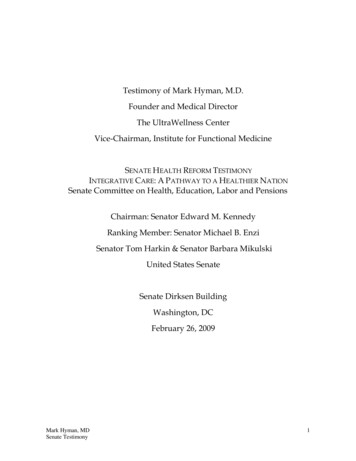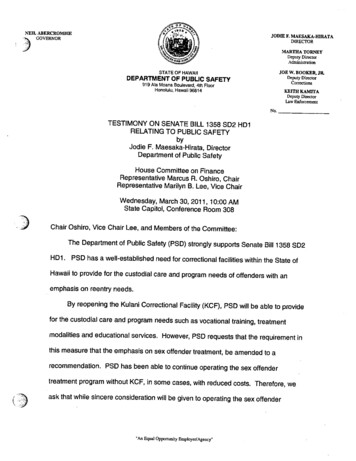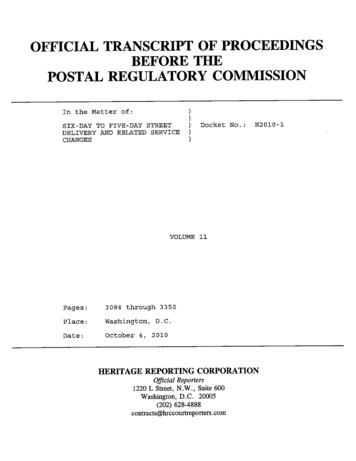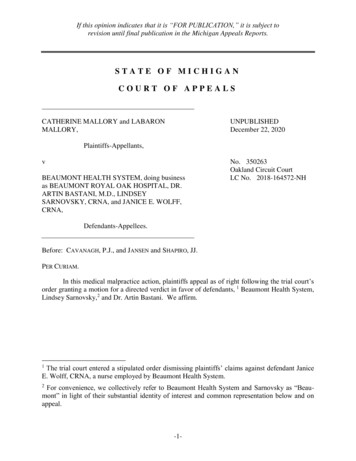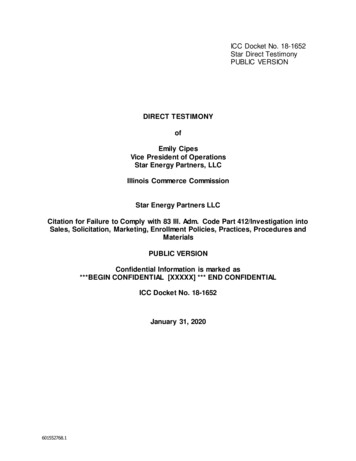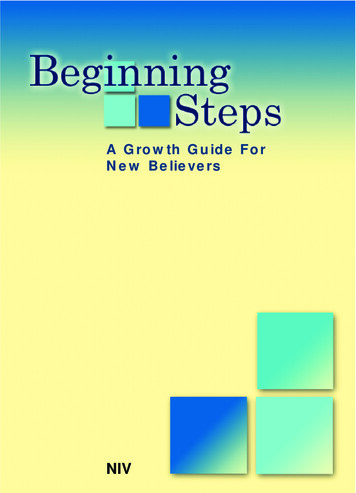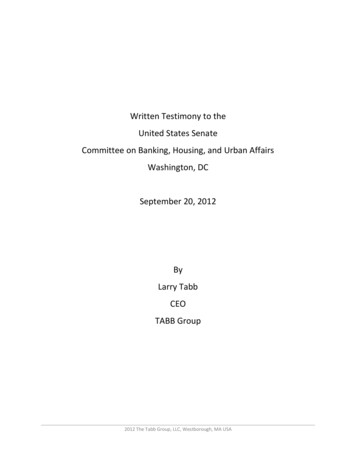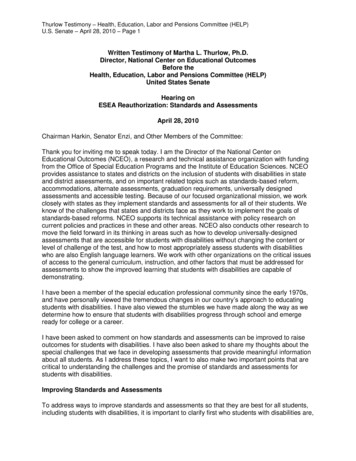
Transcription
Thurlow Testimony – Health, Education, Labor and Pensions Committee (HELP)U.S. Senate – April 28, 2010 – Page 1Written Testimony of Martha L. Thurlow, Ph.D.Director, National Center on Educational OutcomesBefore theHealth, Education, Labor and Pensions Committee (HELP)United States SenateHearing onESEA Reauthorization: Standards and AssessmentsApril 28, 2010Chairman Harkin, Senator Enzi, and Other Members of the Committee:Thank you for inviting me to speak today. I am the Director of the National Center onEducational Outcomes (NCEO), a research and technical assistance organization with fundingfrom the Office of Special Education Programs and the Institute of Education Sciences. NCEOprovides assistance to states and districts on the inclusion of students with disabilities in stateand district assessments, and on important related topics such as standards-based reform,accommodations, alternate assessments, graduation requirements, universally designedassessments and accessible testing. Because of our focused organizational mission, we workclosely with states as they implement standards and assessments for all of their students. Weknow of the challenges that states and districts face as they work to implement the goals ofstandards-based reforms. NCEO supports its technical assistance with policy research oncurrent policies and practices in these and other areas. NCEO also conducts other research tomove the field forward in its thinking in areas such as how to develop universally-designedassessments that are accessible for students with disabilities without changing the content orlevel of challenge of the test, and how to most appropriately assess students with disabilitieswho are also English language learners. We work with other organizations on the critical issuesof access to the general curriculum, instruction, and other factors that must be addressed forassessments to show the improved learning that students with disabilities are capable ofdemonstrating.I have been a member of the special education professional community since the early 1970s,and have personally viewed the tremendous changes in our country’s approach to educatingstudents with disabilities. I have also viewed the stumbles we have made along the way as wedetermine how to ensure that students with disabilities progress through school and emergeready for college or a career.I have been asked to comment on how standards and assessments can be improved to raiseoutcomes for students with disabilities. I have also been asked to share my thoughts about thespecial challenges that we face in developing assessments that provide meaningful informationabout all students. As I address these topics, I want to also make two important points that arecritical to understanding the challenges and the promise of standards and assessments forstudents with disabilities.Improving Standards and AssessmentsTo address ways to improve standards and assessments so that they are best for all students,including students with disabilities, it is important to clarify first who students with disabilities are,
Thurlow Testimony – Health, Education, Labor and Pensions Committee (HELP)U.S. Senate – April 28, 2010 – Page 2and also to realize that (1) students with disabilities have benefited tremendously from ourcountry’s focus on standards and assessments, and (2) standards and assessments, bythemselves, do not guarantee that student performance will increase, or even that access to thegeneral curriculum and instruction will occur.Who students with disabilities are. Students with disabilities are not to be pitied or protectedfrom the same high expectations we have for other students. They should not be excluded fromthe assessments that tell us how we are doing in making sure that they meet thoseexpectations.Students with disabilities who receive special education as required by the Individuals withDisabilities Education Act currently make up 13% of public school enrollment, with percentagesin states varying from 10% to 19% of the state public school enrollment (see Table 1). They aredisproportionately poor, minority, and English Language Learners.Table 1. Number and Percentage of IDEA Part B Children in Highest and Lowest PercentageStatesNumber of Children ServedPercentage of Public SchoolUnder IDEA, Part BEnrollmentHighest Percentage StatesRhode Island20,64619.7New 4317.3Indiana112,94917.1Lowest Percentage 3.4United States TotalSource: Table 52 of 2009 Digest of Ed Statistics.The vast majority– about 80-85% based on the latest distribution of disability categories – arestudents without intellectual impairments (see Figure 1). Rather, they are students who withspecially designed instruction, appropriate access, supports, and accommodations, as requiredby IDEA, can meet the same achievement standards as other students. We must ensure thatthese students progress through school successfully to be ready for college or career. Inaddition, we have learned that even students with intellectual impairments can do more than wepreviously believed possible.Figure 1. Distribution of Disability Categories in 2008-2009
Thurlow Testimony – Health, Education, Labor and Pensions Committee (HELP)U.S. Senate – April 28, 2010 – Page 3In many cases, students have surprised their teachers and parents – and themselves - bymastering content that, before standards-based reform, was never taught to them.Benefits of standards and assessments for students with disabilities. There is no questionthat students with disabilities have benefited in many ways from our country’s focus onstandards and assessments. After decades of being excluded from state and districtassessment systems, their participation in state assessments has increased from 10% or fewerof most states’ students with disabilities participating in the early 1990s, to an average of 99% atthe elementary level, 98% at the middle school level, and 95% at the high school level in 20072008 (Altman, Thurlow, & Vang, 2010). These increases are due in large part to participationrequirements in ESEA and IDEA.We also are seeing evidence of improvements in the academic performance of students withdisabilities. Some of this evidence comes from trends in the performance of students withdisabilities on the National Assessment of Educational Progress (see Figure 2 for 2009 grade 8reading results).
Thurlow Testimony – Health, Education, Labor and Pensions Committee (HELP)U.S. Senate – April 28, 2010 – Page 4Figure 2. NAEP Grade 8 Average Scale Scores of Students with 8227*225*20022003200520072009* significantly different (p .05) from 2009Although there are large gaps in performance between students with disabilities and their peerswithout disabilities, we have built better understanding about students with disabilities, theiropportunities to learn, and what can be expected of them. We have also learned much aboutwhat needs to change in their instruction, access to the curriculum, and in assessments in orderto first see their achievement increase dramatically, and then to capture that achievement onsensitive assessments.Standards and assessments do not guarantee improved results or increased access andinstruction. Standards and assessment are part of a theory of action that has been drivingeducational reform in the U.S. for the past decade or more. It assumes that assessments andaccountability promote interventions and improvements in the quality of instruction, which in turnwill produce higher performance, which is then rewarded through the accountability system.This theory of action has been slow to work for several reasons. First and most basic is thatcurrent instructional practices, especially for students with disabilities, are not uniformly effectivein ensuring success for the students most in need. That is especially true for students withdisabilities. Standards and assessments can be improved, but that is no guarantee that theoutcomes of students with disabilities will be improved. To raise the outcomes of students withdisabilities, we as a nation will need to step up for real change. We must hold our public schoolsaccountable for the learning of students with disabilities, and expect that they commit topractices that we know work. And, given the substantial investment the federal governmentmakes annually in support of special education, there need to be better results. We know it ispossible because we are seeing success for all students in places with a strong commitment tothe learning of all children – all including all students with disabilities. Studies of some of theseplaces have identified what it takes to realize this success:In 2004, the Donahue Institute identified 11 practices that existed in such schools, includingsuch factors as: (a) a pervasive emphasis on curriculum alignment with the state standards,(b) effective systems to support curriculum alignment, (c) emphasis on inclusion and accessto the curriculum, (d) culture and practices that support high standards and studentachievement, (e) well disciplined academic and social environment, (f) use of assessmentdata to inform decision making, (g) unified practice supported by targeted professional
Thurlow Testimony – Health, Education, Labor and Pensions Committee (HELP)U.S. Senate – April 28, 2010 – Page 5development, (h) access to resources to support key initiatives, (i) effective staff recruitment,retention, and deployment, (j) flexible leaders and staff that work effectively in a dynamicenvironment, and (k) effective leadership that is essential to success.The National Center for Learning Disabilities (2008) examined successful schools anddistricts across the nation, identifying two schools and three school districts where thesuccess of students with disabilities was improved. Though different in location and studentdemographics, these schools and districts all (a) included students with disabilities ingeneral education classrooms, (b) used data to adjust instruction to each student’s needs,(c) changed the ways that general education and special education teachers work together,and (d) restructured administrative organizations and procedures.In a recent study of several Ohio school districts where assessment scores showed strongincreases over four years, Silverman, Hazelwood, and Cronin (2009) found that successfuldistricts shared seven key characteristics: (a) focus on teaching and learning as driver of alldecisions, (b) intentional culture shift away from a separate special education model toshared responsibility for all students, eliminating a culture of isolation, (c) collaborationthrough structures and processes to talk about data and inform instruction, (d) leadershipthat starts at the district level and uses data to address issues, with monitoring ofinstructional practice, but shared leadership with principals, building staff, and teacherleaders, (e) instructional practice that ensures access to general curricululm/grade-levelcontent using research-based practices, (f) assessment that includes use of commonformative assessments, and (g) curriculum that is aligned, with use of power standards,pacing guides, curriculum calendars, and a relationship to formative assessment.These three studies, which have looked specifically at what works for students with disabilities,all recognize the importance of standards and assessments. But, they are also about so muchmore – about the student’s access to the curriculum, about a system-wide commitment to allstudents, and about leadership, collaboration, and shared beliefs among the educators whowork with all students, including students with disabilities. Although we can improve standardsand assessments, doing so is not a guarantee of raised outcomes for students with disabilities.Ways to continue to improve standards and assessments. Content standards are thefoundation for improved outcomes for all students, including students with disabilities. Thesestandards should identify what students should know and be able to do. Assessments are themeans to determine where students are in their knowledge and skills in relation to thestandards. A focus on improving standards and assessments should begin by addressingaccessibility and universal design. By accessibility, I mean being easy to approach or enter,regardless of barriers that a student might have. Thus, accessible standards are ones that donot have inherent barriers to their attainment, such as a standard that requires a student who isdeaf to listen. When I use the term universal design, I refer to a set of principles andprocedures that ensure that assessments are appropriate for the widest range of students;universal design techniques can be applied from the beginning of test development to the pointwhen students engage in assessments. The goal of universally designed assessments is toprovide more valid inferences about the achievement levels of all students, including studentswith disabilities.Improving Standards. Our nation has recognized the challenges of each state having its owncontent and achievement standards for students. Those challenges apply to students with
Thurlow Testimony – Health, Education, Labor and Pensions Committee (HELP)U.S. Senate – April 28, 2010 – Page 6disabilities just as they do to students without disabilities. The potential benefits of common corestandards for students with disabilities are great. With clear, well-defined content standards, it ispossible to better identify appropriate accommodations for students with disabilities, both forinstruction and for assessments. And, if we think about all students from the beginning of thedevelopment of the common core standards, we can ensure that we do not inadvertently stateour standards in a way that makes it impossible to accurately measure their knowledge andskills without instead reflecting their disability. By attending to these concerns from thebeginning, we can ensure that rigorous content standards and performance expectations applyto all students, including those with disabilities.Research evidence on teacher use of accommodations, and accommodations decision makingby IEP teams, shows that teachers often have foundational misunderstandings of what thecontent and achievement standards mean. As a result, strategies to adjust instruction throughaccommodations often mean that students are denied access to the content; they are eitherover-accommodated or receive different content than intended by the standards. With clear andspecific, teachable and learnable, measureable, coherent standards, teacher capacity to adjustteaching for individual needs can occur without losing the content or performance expectations.Common core standards that are clearer, fewer, and more rigorous should result in increasedclarity for all, assuming that high quality professional development, training, and supportcontinue for all teachers with all students as the standards are implemented.Reading, writing, speaking, and listening standards – given the nature of the standardsthemselves – often require accommodations for students with disabilities. For example, in thecase of students who are deaf, a standard that calls for “listening” should be interpreted toinclude reading sign language. In a similar vein, “speaking” for some students with speechimpairments, for example, should include “communication” or “self-expression.” Students whoare blind or have low vision should be able to read via braille, screen reader technology, orother assistive technology to demonstrate their comprehension skills. “Writing” should notpreclude the use of a scribe, computer, or speech-to-text technology for students withdisabilities that interfere with putting pen to paper, for example.Assessments. We have made tremendous strides in making assessments more accessible forstudents with disabilities during the past decade. States and test developers have, in general,started the development of their assessments with the recognition that students with disabilitiesare general education students first. The implication of this is that assessments are betterdesigned from the beginning with all students in mind, and should not preclude the participationof most students with disabilities. It is critical that during the development process we think of allstudents, clearly define what each assessment is intended to measure, and how that contentcan be measured for all students. Retrofitting assessments with accommodations anddeveloping a series of alternate assessments because the general assessments do not work forall students is expensive for schools and stigmatizing for students.The research base for developing accountability assessments that are more appropriate for allstudents has dramatically increased in the past several years. Based on this research, NCEOdeveloped five principles for assessments used for accountability (Thurlow et al., 2008): All students are included in assessments in ways that hold schools accountable for theirlearning
Thurlow Testimony – Health, Education, Labor and Pensions Committee (HELP)U.S. Senate – April 28, 2010 – Page 7 Assessments allow all students to show their knowledge and skills on the samechallenging content.High quality decision making determines how students participate.Public reporting includes the assessment results of all students.Accountability determinations are affected in the same way by all students.Continuous improvement, monitoring, and training ensure the quality of the overallsystem.Each of these is supported by specific characteristics of assessment systems that areappropriate for all students, including students with disabilities. All together, they provide animportant framework for any future assessment system.These principles reinforce what we have learned – first, thinking about students whenassessments are first designed, developed, and implemented; second, defining allowableaccommodations as part of the development process; and third, ensuring that the assessmentsystem include all students, without exception. This way, developers have focused on ensuringthat tests really measure what they are intended to measure – not extraneous factors, such aswhether the students can figure out what the test developer means by a question or whether apicture has important clues about the answer to a question (Dolan et al., 2009; Thurlow et al.,2008; Thurlow et al., 2009). Identifying ways to improve assessments for students withdisabilities has, in fact, resulted in improving assessments for all students.What these principles do not do is indicate the specific nature of the assessment. Whatever theassessment approach – computer-based assessments, through course assessments, or paperand pencil end of course assessments – the critical point is to think about the whole populationof students, including students with disabilities. Taking computer-based assessments as anexample – these assessments show promise for increasing the accessibility of assessments.They also make it easier to fall back into some pitfalls that have been demonstrated to createproblems for the assessment of students with disabilities. On the positive side, computer-basedassessments can be developed in a way that embeds what are called “accommodations” whenthe test is paper based, such as the following described by Russell (2008): Users navigate and interact with the functional elements of the test delivery systemusing a standard mouse, keyboard, touch screen, intellikeys, switch mechanism, sipand-puff device, eagle-eyes, and other assistive communication devicesText can be read aloud using a human voice or a synthesized voice, or can be signedAll graphics, drawings, tables, functions, formulas, and other non-text-based elements ofan item can be provided through spoken descriptionsAn auditory calming tool can be provided that allows all students to select from among a list ofpre-approved sound files, and play softly in the background as the user works on the test. Acomputer-based system could record each use of an incorporated feature or accommodation todocument use for individual items as well as overall. There are tremendous possibilities fordramatically increasing the accessibility of assessments in a computer-based assessmentsystem based on grade-level content standards. These assessments also have the potential toaid teachers as they determine how to move students to grade-level achievement.Computer-based systems also make it easier to fall back into some pitfalls that have beendemonstrated to create problems for the assessment of students with disabilities. We must
Thurlow Testimony – Health, Education, Labor and Pensions Committee (HELP)U.S. Senate – April 28, 2010 – Page 8avoid pitfalls of the past in designing computer-based systems. They should be developed to beas transparent as possible about the content on which students are assessed and the ways inwhich the content is assessed. They should not revert to normative assessments, whichcompare students only to each other rather than to content standards, even in the name ofbeing able to measure growth. Title I evaluation systems prior to 1994 were based on thesetypes of approaches, and demonstrated dramatically that schools can show that students make“progress,” but the progress is meaningless if it is not tied to the intended content andachievement targets. These practices resulted in the failure of the system in identifying whereschools were succeeding and where they were not. Students remained far behind their peers –and even increased the achievement gaps - in schools deemed successful based on flawedtesting assumptions. Computer-based systems should not revert to an out-of-level testingapproach. To avoid the mistakes of the past, any adaptive computer-based assessments mustbe on grade-level. Even when constrained to grade-level, adaptive testing practices must betransparent enough to detect when a student is inaccurately measured because of splinter skillscommon for some students with disabilities, for example, with poor basic skills in areas likecomputation and decoding, but with good higher level skills, such as problem solving, built withappropriate accommodations to address the barriers of poor basic skills.The research base has dramatically increased for new forms of assessments, like alternateassessment based on alternate achievement standards (AA-AAS), developed to measure theacademic achievement of a very small number of students who have the most significantcognitive disabilities. NCEO, in collaboration with the National Alternate Assessment Center(NAAC) has conducted an extensive literature review and has identified ten commonmisperceptions about AA-AAS, as well as research-based recommendations to ensure commonunderstanding and high quality assessments (Quenemoen, Kearns, Quenemoen, Flowers, &Kleinert, 2010). A summary of the research-based recommendations is included in Appendix A.Challenges in Promoting Improved Achievement for Students with DisabilitiesOur greatest challenges in improving achievement for students with disabilities are NOT in thearea of assessments. But including all students in assessment and accountability systems aswell as requiring reporting of assessment results broken out by student groups that historicallyunderperform has been critical in helping us understand our great challenges. These greatestchallenges are in delivering high quality instruction in the standards-based curriculum to everystudent with a disability. Although there are some ways in which assessments can be improved,the real work that needs to be done is in providing students with disabilities greater access tothe curriculum, making sure that they have the individualized instruction required by IDEA aswell as appropriate accommodations and other supports they need to succeed. States that havedone this have seen the improved results.We know how to educate all children, including those with disabilities, if we have the will to doso. The discussion should not be about whether students with disabilities can learn toproficiency – and thus, it should not be about whether they should be included in theassessment and accountability measures we have for all students – it must be about whetherwe have the will and commitment to make it happen. We must build on the research that hasshown that where there is shared responsibility and collaboration among staff, and wherestudents are held to high expectations and are provided specialized instruction, supports andaccommodations so that they can meet those high expectations, students score higher onassessments.
Thurlow Testimony – Health, Education, Labor and Pensions Committee (HELP)U.S. Senate – April 28, 2010 – Page 9Still, there are some risks as we move forward to develop assessments based on common corestandards. It is too easy to explain away the gaps in achievement for students with disabilitiesby characterizing these students as poor little children who should not be held to the samestandards as others because of their disabling condition. This characterization is inconsistentwith what we know about students with disabilities – and flies in the face of the purpose ofspecial education. We should expect to see a value-added benefit from the Federal commitmentto supplementing state and local funding for special education services. This benefit will berealized through the unwavering expectation that all students with disabilities receive highquality and specialized instruction, have universal access to the challenging grade-levelcurriculum that is the right of all students, and participate in rigorous and inclusive assessmentsof their learning.Thank you.ReferencesAltman, J., Thurlow, M., & Vang, M. (2010). Annual performance report: 2007-2008 state assessmentdata. Minneapolis, MN: University of Minnesota, National Center on Educational Outcomes.Dolan, R. P., Burling, K. S., Harms, M., Beck, R., Hanna, E., Jude, J., Murray, E. A., Rose, D. H., & Way,W. (2009). Universal design for computer-based testing guidelines. Iowa City, IA: Pearson.Donahue Institute (2004), A study of MCAS achievement and promising practices in urban specialeducation. Hadley, MA: University of Massachusetts Donahue Institute.National Center for Learning Disabilities. (2008). Challenging change: How schools and districts areimproving the performance of special education students. New York: Author.Quenemoen, R., Kearns, J., Quenemoen, M., Flowers, C., & Kleinert, H. (2010). Common misperceptionsand research-based recommendations for alternate assessment based on alternate achievementstandards (Synthesis Report 73). Minneapolis, MN: University of Minnesota, National Center onEducational Outcomes.Russell, M. (2008). Universal design of computer-based tests: RFP language. Unpublished document,Boston College.Silverman, S.K., Hazelwood, C., & Cronin, P. (2009). Universal education: Principles and practices foradvancing achievement of students with disabilities. Columbus, OH: Ohio Department of Education.Thurlow, M.L., Quenemoen, R.F., Lazarus, S.S., Moen, R.E., Johnstone, C.J., Liu, K.K., Christensen,L.L., Albus, D.A., & Altman, J. (2008). A principled approach to accountability assessments for studentswith disabilities (Synthesis Report 70). Minneapolis, MN: University of Minnesota, National Center onEducational Outcomes.Thurlow, M. L., Laitusis, C. C., Dillon, D. R., Cook, L. L., Moen, R. E., Abedi, J., & O’Brien, D. G. (2009).Accessibility principles for reading assessments. Minneapolis, MN: National Accessible ReadingAssessment Projects.
Thurlow Testimony – Health, Education, Labor and Pensions Committee (HELP)U.S. Senate – April 28, 2010 – Page 10Appendix A:Rethinking Assumptions about Alternate Assessment based onAlternate Achievement StandardsTo facilitate the process of rethinking assumptions about alternate assessments based onalternate achievement standards (AA-AAS), common misperceptions are identified first, followedby the assumptions underlying them and a research response to those assumptions. Acomprehensive summary of the literature underlying the research responses is provided inCommon Misperceptions and Research-based Recommendations for Alternate Assessmentbased on Alternate Achievement Standards (NCEO Synthesis Report 73 by Quenemoen,Kearns, Quenemoen, Flowers, & Kleinert).Common misperception #1 – Many students who take the AA-AAS function more like infantsor toddlers than their actual age, so it makes no sense for schools to be held accountable fortheir academic performance.Assumptions Underlying Misperception:Some people assume that students whotake the AA-AAS have such severedisabilities that they are unable to learnacademic content. Sometimes, thismisperception is rooted in the assumptionthat all students must progress throughtypical infant and preschool skilldevelopment before any other academicinstruction can occur.Research Response: First, learnercharacteristics data from many states showus that MOST students who participate inAA-AAS have basic literacy and numeracyskills. Second, we have understood formany decades that waiting until thesestudents are “ready” by mastering allearlier skills means they “never” will begiven access to the skills and knowledgewe now know they can learn. In the 1980s,educators realized that students withsignificant disabilities could learnfunctional skills to prepare for independentadult life, even before mastering all lowerskills. In recent years, research suggeststhat these students can often also learn ageappropriate academic skills and knowledgeeven when they have not mastered allearlier academic content.Research-based Recommendation: Build accountability systems to ensure that allstudents who are eli
Thurlow Testimony - Health, Education, Labor and Pensions Committee (HELP) U.S. Senate - April 28, 2010 - Page 4 227* Figure 2. NAEP Grade 8 Average Scale Scores of Students with Disabilities

